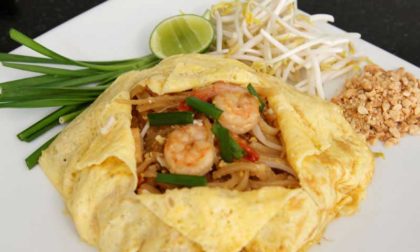Popular Fruits in Phuket Thailand
When it comes to fruits in Phuket, Thailand, the country, with its great variety and diversity, is a veritable Garden of Eden. Thailand is blessed with a climate that permits almost any type of tropical fruit to flourish and, surprisingly enough, many fruits and vegetables we automatically take as being Southeast Asian natives are in fact imports from Africa and South America, with a few notable exceptions such as the notorious durian and the ever-present banana.
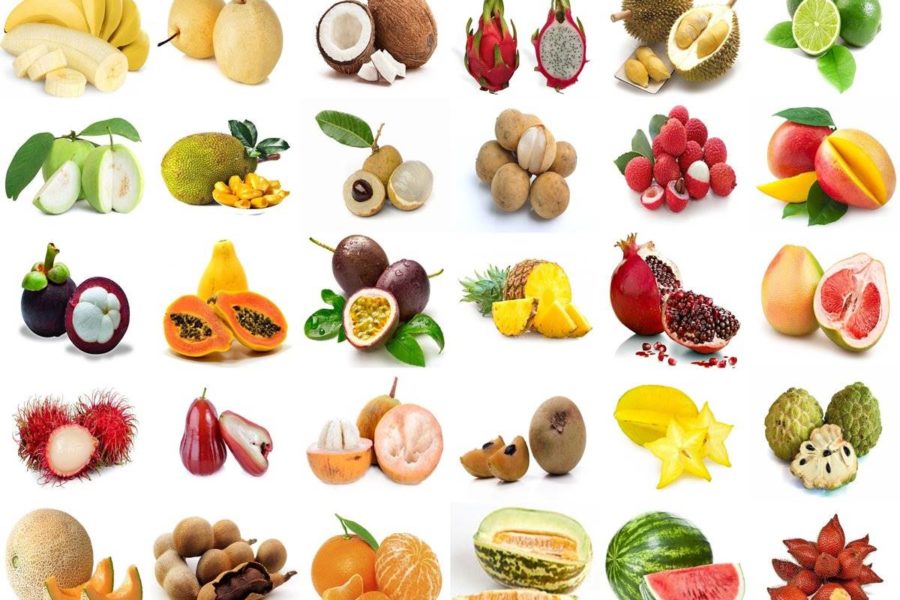 In our globalized world, here in Phuket, you can find most generic fruits available in Europe and, with the progress in agriculture and transportation, strains such as grapes, apples, cherries or pears cultivated in the north of Thailand or imported from the USA, Australia, Japan or Europe, are readily available in the fruit and vegetable aisles of most Thai supermarkets and markets. The north of Thailand has three distinct seasons while the south has two, which allows fruit lovers to sample the myriad seasonal harvests throughout the year.
In our globalized world, here in Phuket, you can find most generic fruits available in Europe and, with the progress in agriculture and transportation, strains such as grapes, apples, cherries or pears cultivated in the north of Thailand or imported from the USA, Australia, Japan or Europe, are readily available in the fruit and vegetable aisles of most Thai supermarkets and markets. The north of Thailand has three distinct seasons while the south has two, which allows fruit lovers to sample the myriad seasonal harvests throughout the year.
To put it lightly into perspective, there’s a strong fruit culture in Thailand, one in which most local people look forward to their seasonal favorites. And when the particular season comes, free entrepreneurship is pretty common, allowing small producers and landowners to sell fruits at local markets and at roadside stalls, so it’s really not that hard, and indeed a lot of educational fun, to explore the Thai kingdom’s fruit choices. First-time visitors are often fascinated to discover fruits in Phuket Thailand that they’d never even heard of, let alone seen, before visiting the country.
The particular way of enjoying fruits in Phuket Thailand can also be a bit surprising, as many are often eaten with quirky seasonings: watermelon with dried fish, shallot and sugar; guava with salt and chili; green mango with fish sauce, coconut sugar, shallot and dried shrimp; gooseberry with shrimp paste; yellow mango with coconut milk and sticky rice… It’s a never-ending list, with a lot of westerners asking: “Why on earth don’t Thai people simply eat their fruits raw and unadulterated in their original forms?”
The answer is that Thai people have long understood how the delicate balance between sweet, sour, salty and bitter brings out the best in each individual fruit. Thai cuisine is world-renowned for its masterful combinations of tastes and textures, and its fruit culture is by no means less colorful and certainly a pleasure to explore.
Among the myriad of fruits available in the markets around the country, we have selected 30 of the most popular fruits in Phuket. We will present them to you with their English, Thai (with an English phonetic/transcription in brackets) and scientific names, together with the season they are at hand in the marketplaces, as well as their taste types and their nutritive values. In our “enhance” individual description of each fruit, you’ll learn how to combine their tastes, where they originated from, what are their main nutritive attributes, and might come upon a few interesting facts that might kindle your curiosity.
This way, you can take pleasure in an unparalleled gastronomic journey on your next visit to Phuket. It’s a fascinating and healthy fruits world to explore.
Enjoy Thai fruits!
| Phuket Fruits | Name | Season | Taste | Nutritive Value |
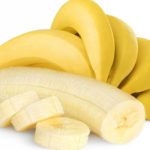 | Banana (กล้วย – Gluay) Musa acuminata | Year-round | Sweet (creamy) | Good source of carbohydrates and Vitamin B-6 |
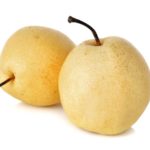 | Chinese Pear (สาลี่ – Salee) Pyrus pyrifolia | August-November | Sweet (juicy) | Good source of dietary fiber, potassium and vitamin C |
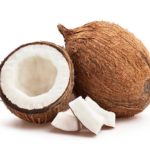 | Coconut (มะพร้าว – Mapraw) Cocos nucifera | Year-round | Sweet (juicy) | Good source of carbohydrates and multiple minerals |
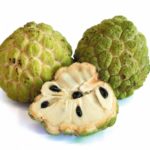 | Custard-apple (น้อยหน่า – Noinah) Annona reticulata | June-September | Sweet (custard like) | Rich in vitamin C & B-6 and manganese |
 | Dragon Fruit (แก้วมังกร – Gael Mangon) Hylocereus undatus | Year-round | Sweet (juicy/crunchy) | Rich in carbohydrates, antioxidants and vitamin C |
 | Durian (ทุเรียน – Thurian) Durio zibethinus | April-August | Sweet (custard like) | Rich in carbohydrates, minerals and vitamin C & B |
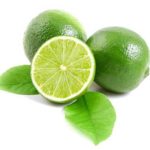 | Green Lemon (มะนาว – Manow) Citrus × aurantiifolia | Year-round | Sour | Good source of vitamin C |
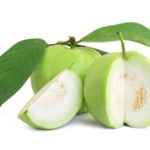 | Guava (ฝรั่ง – Farang) Psidium guajava | Year-round | Mildly acidic | Rich in vitamin C, dietary fiber and lycopene |
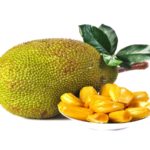 | Jackfruit (ขนุน – Khanon) Artocarpus heterophyllus | Year-round | Sweet (unique) | Good source of minerals and vitamin B & C |
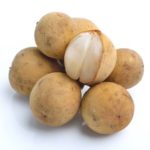 | Langsat (ลางสาด – Langsad) Lansium domesticum | July-October | Sweet and sour (juicy) | Good source of carbohydrates, phosphorus and vitamin A & B |
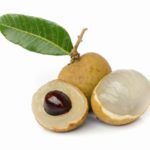 | Longan (ลำไย – Lamyai) Dimocarpus longan | June-August | Sweet (juicy) | Good source of vitamin C and minerals |
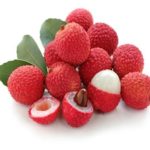 | Lychee (ลิ้นจี่ – Linchi) Litchi chinensis | April-May/June | Sweet (juicy) | Good source of potassium, antioxidants and vitamin C |
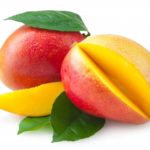 | Mango (มะม่วง – Mamuang) Mangifera indica | October-May (green) March-June (yellow) | Somewhat Neutral Sweet (juicy) | Rich in vitamins, minerals, dietary fiber and antioxidants |
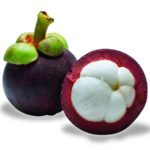 | Mangosteen (มังคุด – Mangkud) Garcinia mangostana | May-October | Sweet and slightly sour | Rich in antioxidants and minerals |
 | Papaya (มะละกอ – Malakaw) Carica papaya | Year-round | Sweet and slightly sour | Good source of folic acid and vitamin C & A |
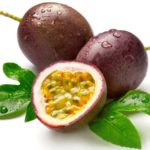 | Passion Fruit (เสาวรส – Saowarod) Passiflora edulis | Year-round | Mildly acidic | Rich in vitamin C, minerals, fiber and antioxidants |
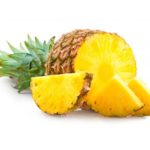 | Pineapple (สัปปะรด – Saparod) Ananas comosus | Year-round | Sweet and mildly acidic | Rich source of manganese and vitamin C |
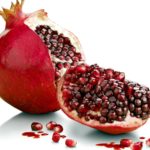 | Pomegranate (ทับทิม – Tubtim) Punica granatum | March-May | Sweet | Good source of antioxidants and vitamin K, C & E |
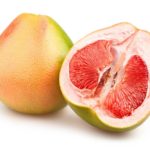 | Pomelo (ส้มโอ – Som-O) Citrus maxima | October-February | Sweet and slightly bitter | Good source of potassium, dietary fiber and vitamin C |
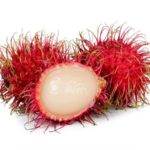 | Rambutan (เงาะ – Ngoh) Nephelium lappaceum | May-September | Sweet and mildly acidic | Good source of manganese |
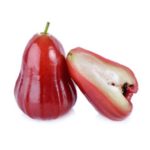 | Rose Apple (ชมพู่ – Chompoo) Syzygium samarangense | Year-round | Sweet with slightly bitter aftertaste | Good source of vitamin C, potassium and calcium |
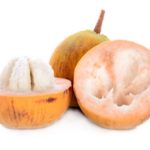 | Santol (กระท้อน – Kratoan) Sandoricum koetjape | July-October | Sweet and sour (creamy) | Good source of antioxidants, carbohydrates and vitamin B & C |
 | Sapodilla (ละมุด – Lamud) Manilkara zapota | July-December | Sweet with malty flavour (juicy) | Rich in vitamin C, potassium, iron and carbohydrates |
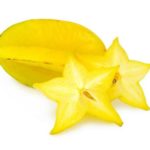 | Star Fruit (มะเฟือง – Mafaeng) Averrhoa carambola | October-December | Sweet with hint of sour (juicy) | Rich in antioxidants, potassium and vitamin C |
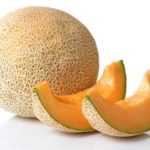 | Sugar Melon (แคนตาลูป – Cantalope) Cucumis melo cantalupensis | Year-round | Sweet | Good source of vitamin C & A |
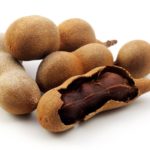 | Tamarind (มะขาม – Makahm) Tamarindus indica | November-February | Sweet and sour | Good source of vitamin B, magnesium and iron |
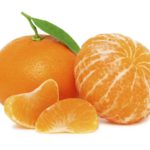 | Tangerine (ส้มเขียวหวาน – Som Kiewwaan) Citrus reticulata | September-February | Sweet (juicy) | Rich in vitamin C, dietary fiber and potassium |
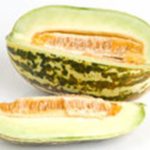 | Thai Melon (แตงไทย – Tangtai) Cucumis melo | Year-round | Sweet (juicy) | Good source of vitamin C & A |
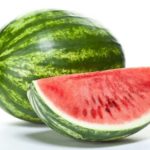 | Watermelon (แตงโม – Tangmo) Citrullus lanatus | Year-round | Sweet (juicy & crisp) | Good source of antioxidants, lycopene and vitamin C |
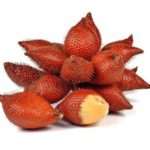 | Zalacca (สลัก – Salak) Salacca zalacca | Year-round | Sweet and mildly acidic | Good source of iron, calcium and vitamin C |
30 Popular Fruits in Phuket

Banana | (กล้วย – Gluay) | Musa acuminata
In the west we’re used to seeing just one type of banana: the standard Cavendish strain which accounts for 47% of global banana production (therein lies a monopoly). In Phuket fruit markets there are many different types and, what’s more, like the papaya they grow just about everywhere and are as common a sight as hedges in the west. There’s almost no need to describe the delicious mushy sweet flesh of the common banana as we’re so used to them, but what about the banana flower? That huge mauve, almost sexual-like protuberance, at the end of a stem of bananas? Locals regard this as a treat and chop it up to mix in salads, usually with coconut milk, and it even appears in stir-fries.
The banana is indigenous to Thailand and locals use almost every part of the banana tree. The leaves can be used as a food wrapping, a serving plate, ceremonial lanterns, roofing material and even sometimes as wooden floor polish! You’ll see banana leaves on sale in the fresh markets throughout the land folded up like freshly-prepared bed sheets. And perhaps the quaintest use of the tree is to make little ‘boats’ or floats of segments of the trunk during the water festival of Loy Krathong in Autumn.
Nutritional value (concise) per 100 gr – Calories 89:
Carbohydrate 22.84 g / Fat 0.33 g / Protein 1.09 g
Vitamin C 8.7 mg / Vitamin B 1.503 mg / Potassium 358 mg / Phosphorus 22 mg / Magnesium 27 mg / Sodium 1 mg / Iron 0.26 mg / Manganese 0.27 mg / Zinc 0.15 mg / Water 74.91 g
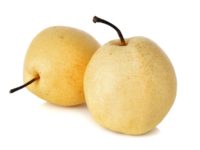
Chinese Pear | (สาลี่ – Salee) | Pyrus pyrifolia
Not as common as most fruits in Phuket on this list, the Chinese pear is nevertheless found throughout Southeast Asia under several names such as the Korean pear, the Japanese pear, and the Taiwanese pear. It’s therefore not surprising to learn that its generic name is the Asian pear. Grainier than its European counterpart, the Chinese pear is generally not used as much in cooking as other fruits but rather consumed raw, yet at the same time, it can be used as a sweetening base for soy sauces and curries.
Many people have compared this pear’s texture to that of apples, and indeed the high fiber content is a definite plus when it comes to health issues. Other benefits of consuming the Chinese pear are its micronutrients that are important for blood, bone and cardiovascular health. Unbelievably, one Asian pear provides approx 12% of your daily vitamin C needs. Here, Asian pears are in season in the autumn months.
Nutritional value (concise) per 100 gr – Calories 42:
Carbohydrate 10.65 g / Fat 0.23 g / Protein 0.5 g
Vitamin C 3.8 mg / Vitamin B 0.33 mg / Vitamin E 0.12 mg / Vitamin K 4.5 mcg
Potassium 121 mg / Phosphorus 11 mg / Magnesium 8 mg / Calcium 4 mg / Manganese 0.06 mg
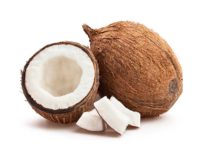
Coconut | (มะพร้าว – Mapraw) | Cocos nucifera
According to legends and the oldest history books, coconuts have been around for as long as men have inhabited the earth. Apart from their fruits, coconuts have been used for ever to produce fiber, fuel, traditional folk medicine and much more day to days basic produce such as edible oil, mattress, and even musical instruments.
As a fruit, coconut is one of the most versatile fruit there is available on the market: its juice is sweet, refreshing, and provides more healthy body fluids than water; its meat, when young as the Thai like their coconuts, can be eaten fresh or dried, as a sweet or in all kind of delicious curry dishes (especially in the southern provinces of Thailand). It is also used to produce numerous cosmetics, as well as oil (for its soothing effects on the body and soul) for massages in Thai spas all over the country.
All year round, coconuts can be found in markets, restaurants, on the beach and even on the side of the road in Thailand. Being loaded with naturally sterile electrolytes and a great provider of dietary fibers and minerals such as manganese, potassium, phosphorus, and coconuts are by far the most complete and nutritious fruits you can find around.
Nutritional value (concise) per 100 gr – Calories 354:
Carbohydrate 15.23 g / Fat 33.49 g / Protein 3.33 g
Vitamin C 3.3 mg / Vitamin B 0.980 mg / Vitamin E 0.24 mg / Vitamin K 0.2 mcg
Potassium 356 mg / Phosphorus 113 mg / Magnesium 32 mg / Calcium 14 mg / Sodium 20 mg / Iron 2.43 mg / Manganese 1.5 mg / Zinc 1.10 mg / Copper 0.435 mg / Selenium 10.1 mcg
Water 46.99 g
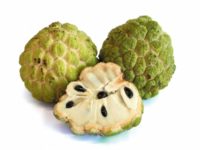
Custard-apple | (น้อยหน่า – Noinah) | Annona reticulata
This fruit is understandably sometimes known as the bullock’s heart, or bull’s heart, and is simply one of the tastiest among the fruits in Phuket. Grown widely throughout the tropics and the warmer subtropics on a semi-evergreen shrub or small tree about eight meters tall, the fruit can vary in shape and size but is generally about baseball size, round in shape and bears a resemblance to a small pine cone. The fleshy fruit comes apart in segments, is very sweet to the taste, white to light yellow in color, and looks as well as tastes like custard.
Custard-apple, also known as sugar-apple, has a very discrete sweet-smelling fragrance, is a little grainy and a bit oily in texture, and has a very sweet and very subtle taste. The hard shiny seeds may number 20 to 40 or more per fruit, and have a brown to black coat, although varieties exist that are almost seedless. If you really want to up the ante in your Thai fruits taste experience, keep an eye out for custard apple ice cream!
Nutritional value (concise) per 100 gr – Calories 94:
Carbohydrate 23.64 g / Fat 0.29 g / Protein 2.06 g
Vitamin C 36.3 mg / Vitamin B 1.532 mg
Potassium 247 mg / Phosphorus 32 mg / Magnesium 21 mg / Calcium 24 mg / Sodium 9 mg / Iron 0.6 mg / Manganese 0.42 mg / Zinc 0.1 mg
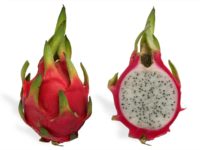
Dragon Fruit | (แก้วมังกร – Gael Mangon) | Hylocereus undatus
Known in Thai as ‘gael mangon’ (meaning ‘glass dragon’ in English), the dragon fruit is an exotic-looking medium-sized fruit with a rough exterior and an unusual interior. The fruit originated in Mexico where there are several strains and rind colors. It was subsequently re-planted in Central America, eventually making its way to the compatible climates of Israel, Southeast Asia, Australia, and the USA as well as the Canary Islands. The mother plant is a cactus, and the fruit itself varies in weight from approx 150 g to a whopping 600 g.
Visually, the dragon fruit that you are likely to encounter in Phuket fruit markets has a rough pinkish non-edible ‘dragon-like’ exterior, with juicy white flesh dotted with tiny black scrunchy seeds, not unlike the kiwi fruit. The taste of dragon fruit is more pleasing and refreshing than sensational. With little or no cholesterol, lots of vitamin C and antioxidants, as well as fruit fats and fiber, the dragon fruit is packed with goodness. Dragon fruits are largely available towards the end of the monsoon season from late September onward.
Nutritional value (concise) per 100 gr – Calories 264:
Carbohydrate 82.14 g / Fat 0.0 g / Protein 3.57 g
Vitamin C 6.4 mg
Calcium 107 mg / Sodium 30 mg
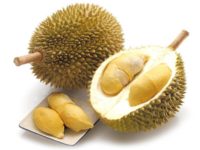
Durian | (ทุเรียน – Thurian) | Durio zibethinus
The so-called ‘king of fruits‘, the durian and its all-pervading odor (some would say ‘stink’), is hard to avoid from May to August every year in Thailand. It’s one of those love-it-or-hate-it experiences – for eating durian is indeed an experience.
Some of the descriptions of this fruit are almost painfully vivid: “Smells like him, tastes like her”, “Smells like hell, tastes like heaven”. With its spiky rind (‘duri’ means ‘spike’ in Malay-Indonesian), it looks quite threatening, and you can actually get sent to jail in Thailand for striking a person with a durian. Some hotels ban the eating of this fruit on their premises because of the severe reactions to its smell and the fact that the odor remains in rooms for days on end after consuming it.
OK! But what of the taste? “A rich custard highly flavored with almonds… The more you eat of it, the less you feel inclined to stop.” wrote Alfred Russell Wallace in the 19th century. Others are less complimentary: “Its odor is best described as pig-shit, turpentine and onions, garnished with a gym sock.” says travel and food writer Richard Sterling. Put simply, it’s delicious for some and repulsive to others.
Be aware that it’s not wise to combine durian with alcohol because of its high carbohydrate content which may result in heartburn.
Nutritional value (concise) per 100 gr – Calories 147:
Carbohydrate 27.09 g / Fat 5.33 g / Protein 1.47 g
Vitamin C 19.7 mg / Vitamin B 2.2 mg / Vitamin A 44 mcg
Potassium 436 mg / Phosphorus 39 mg / Magnesium 30 mg / Calcium 6 mg / Sodium 2 mg / Iron 0.43 mg / Manganese 0.325 mg / Zinc 0.28 mg / Copper 0.207 mg
Water 65 g
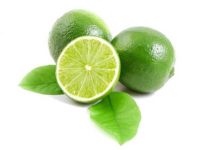
Green Lemon | (มะนาว – Manow) | Citrus × aurantiifolia
Green Lemon, also known as lime, is an integral part of Thai cuisine and plays a major role in dishes such as ‘som tam’ (papaya salad) to simple chicken fried rice. Until a few years ago, green lemon was the only homegrown choice for a sharp tangy accompaniment to seafood dishes and acidic fruit drinks, but lately Chiang Mai farms have been producing western lemon strains.
Once a closely guarded secret by the British navy in its fight against shipboard scurvy, limes contain a powerful punch of vitamin C, and have the ability to cut through heavy sauces and dishes, thus lending a lightness and a pleasant tang to such standards as ‘phad thai’ fried noodles. It’s not uncommon to see 500 ml plastic bottles of lime juice at local markets and even in supermarkets for as little as 15 baht! Its zest (grated rind) is also a valuable ingredient in several local dishes. Health-wise limes are high in water and vitamin C content but, apart from minerals and certain acids, precious little else.
Nutritional value (concise) per 100 gr – Calories 30:
Carbohydrate 10.5 g / Fat 0.2 g / Protein 0.7 g
Vitamin C 29.1 mg / Vitamin B 0.523 mg
Potassium 102 mg / Phosphorus 18 mg / Magnesium 6 mg / Calcium 33 mg / Sodium 2 mg / Iron 0.6 mg
Water 88.3 g
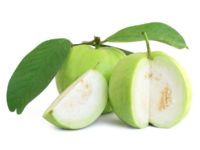
Guava | (ฝรั่ง – Farang) | Psidium guajava
The Thais call guavas ‘falang’ or ‘farang’ which, funnily enough, is the same term they use to describe foreigners. The all-year-round and mildly acidic tasting guavas are roughly the size of a robust apple, and they feel dense to the touch, with tightly packed white flesh contained in a light-green skin. Native to the Amazon region, guava has many medicinal properties and actually contains more vitamin C than citrus fruits!
Once the flesh is cut into, it rapidly oxidizes (similar to eggplants) and turns a mushy brown, so be sure to consume it all as soon as you dissect the fruit. If buying at the roadside or at the market, vendors will have a whole fruit cut up in seconds. The fruit wedges are tossed into a clear plastic food bag, which the vendor will usually put into another small plastic shopping bag along with a packet containing a mixture of sugar, salt, hot dried chilies, and one or two bamboo skewers.
Nutritional value (concise) per 100 gr – Calories 68:
Carbohydrate 14.32 g / Fat 0.95 g / Protein 2.55 g
Vitamin C 228.3 mg / Vitamin B 1.752 mg / Vitamin A 31 mcg / Vitamin K 2.2 mcg
Potassium 417 mg / Phosphorus 40 mg / Magnesium 22 mg / Calcium 18 mg / Sodium 2 mg / Iron 0.26 mg / Manganese 0.15 mg / Zinc 0.23 mg
Lycopene 5204 mcg
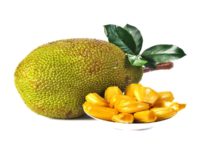
Jackfruit | (ขนุน – Khanon) | Artocarpus heterophyllus
Originally from the rainforests of South and Southeast Asia, the impressive-looking jackfruit (‘khanon’ in Thai) is found widely throughout Thailand fruit markets. Huge in appearance, jackfruit has very thick skin, and pods can reach 36 kg in weight and grow up to 90 cm long. It certainly is one of the strangest looking fruits in Phuket and the region.
Inside the imposing pod’s green stubby and bumpy skin are bright yellow segments of flesh that have an almost rubbery feel to them, yet are tender when bitten into. The best time to find jackfruit in this country is towards the end of the rainy season in October onwards. Because of the fruit’s size, it’s pretty unlikely that you’ll be buying it whole, so simply buy a bag or two of the flesh at the local market and tuck in. Jackfruit is a welcome addition to Southeast Asia curries as it tenderizes easily and is extremely tasty.
Nutritional value (concise) per 100 gr – Calories 95:
Carbohydrate 19.08 g / Fat 0.64 g / Protein 1.72 g
Vitamin C 13.83 mg / Vitamin B 1.644 mg / Vitamin E 0.34 mg / Vitamin A 5 mcg
Potassium 448 mg / Phosphorus 21 mg / Magnesium 29 mg / Calcium 24 mg / Sodium 2 mg / Iron 0.23 mg / Manganese 0.043 mg / Zinc 0.13 mg
Water 86.5 g
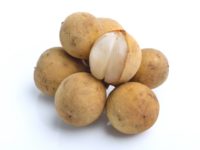
Langsat | (ลางสาด – Langsad) | Lansium domesticum
Langsat, also known in English as Longkong (a thinner-skinned cousin) or Lanzones, is a tropical fruit with its origin in the western part of Southeast Asia and grown mostly in the southern part of Thailand, Malaysia, Indonesia, and the Philippines. The fruits, which look a bit like small potatoes and are bundle in clusters similar to grapes, can be found in Phuket fruit markets all over the kingdom between the months of July and October.
The meat of the fruit itself is translucent with a slimy texture, which is a bit reminiscent of the passion fruit. Langsat is a sweet and very juicy fruit with a little touch of sour to it that tastes a bit like an amalgam of grapefruit and grapes and is the perfect fruit to quench the thirst. The sweet juicy flesh contains sucrose, fructose, glucose and is rich in vitamin B and phosphorus.
Nutritional value (concise) per 100 gr – Calories 10:
Carbohydrate 7.7 to 14.3 g / Fat 0.2 g / Protein 0.5 to 0.8 g
Vitamin C 4.1 to 13 mg / Vitamin B 0.57 mg / Vitamin A 13 mcg
Phosphorus 20.5 mg / Calcium 10.8 to 20 mg / Iron 1 mg
Water 86.5 g
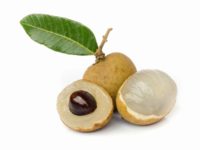
Longan | (ลำไย – Lamyai) | Dimocarpus longan
Originally brought into Thailand by Chinese immigrants several hundred years ago, longans were first planted in Bangkok, but nowadays it is in the north that the fruit has flourished and grown into one of Thailand’s largest exported fruit. Known as ‘lamyai’ in Thai, the longan is called a ‘dragon eye’ in Chinese because, when shelled, the translucent whitish flesh reveals a black center seed eerily resembling an iris.
The seed can be boiled and eaten as a nut, while the shell is inedible. The soft flesh can be eaten fresh and is also used in soups, snacks as well as sweet-and-sour dishes. Like lychees, longans are also canned and served in syrup, and they also share several characteristics, not the least of all their delicate flavors. Rich in vitamin C, longans are well respected in the medical community for their multiple health benefits and are available year-round in Thailand.
Nutritional value (concise) per 100 gr – Calories 60:
Carbohydrate 15.14 g / Fat 0.1 g / Protein 1.31 g
Vitamin C 84 mg / Vitamin B 0.471 mg
Potassium 266 mg / Phosphorus 21 mg / Magnesium 10 mg / Calcium 1 mg / Iron 0.13 mg / Manganese 0.052 mg / Zinc 0.05 mg
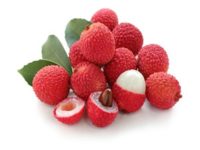
Lychee | (ลิ้นจี่ – Linchi) | Litchi chinensis
Originally from Southern China, lychees thrive in northern Thailand from April to May/June and are available canned in syrup during the rest of the year. The lychee subtle and juicy mix of tart flavor is almost addictive and defies description like no other fruit does.
The translucent white flesh is covered by a pink leathery rind that is easy to remove, and the flesh contains an inedible seed, so take care when biting after peeling it. This oval-shaped fruit is roughly the size of a golf ball and is sold in bunches directly off the tree. High in vitamin C, lychees have around the same calorie count as table grapes. It’s definitely a fruit you should try when visiting Phuket.
Nutritional value (concise) per 100 gr – Calories 66:
Carbohydrate 16.53 g / Fat 0.44 g / Protein 0.83 g
Vitamin C 71.5 mg / Vitamin B 0.779 mg
Potassium 171 mg / Phosphorus 31 mg / Magnesium 10 mg / Calcium 5 mg / Sodium 1 mg / Iron 0.13 mg / Manganese 0.055 mg / Zinc 0.07 mg
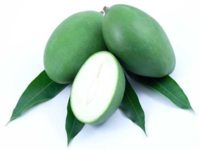
Mango | (มะม่วง – Mamuang) | Mangifera indica
Mangoes are native to South Asia (it’s the national fruit of India, Pakistan, and the Philippines), and an integral part of the Thai diet. Mangoes have been cultivated for quite some time now: the Hindu Vedas (written about 4,000 B.C.) refer to mangoes as ‘the food of the gods’, while Buddha was said to have rested in a mango grove. The word mango comes from a Portuguese corruption of the Tamil term for the fruit, ‘man-kay’.
The green mango is essentially an unripe fruit (some varieties actually taste better unripe) that is sliced, and then used in side dishes complemented by sugar, dried chili, dried shrimps and fish sauce. It is as well used in chutney sauces. Its texture is that of a slightly unripe apple or guava (though not as acidic or tart), and it tastes somewhat neutral, quite unlike a ripe or yellow mango. Green mangoes are in season from early October to May and are sold everywhere.
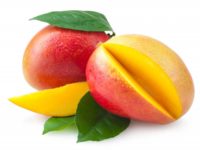
The ripened version of the green mango, ‘mamuang’ in Thai, is truly a delicious treat, and can be consumed in myriad ways: as a dessert with glutinous rice and coconut cream, in smoothies, as an ice cream topping, as an addition in curries (usually coconut-based), or simply all alone with no accompaniment whatsoever.
Peel the leathery skin off by cross-sectioning with a knife, and remove the soft flesh from the large central stone or pit. It’s in season from March to June, although recently various methods have been employed to extend this to year-round for several versions of the fruit.
Nutritional value (concise) per 100 gr – Calories 60:
Carbohydrate 15 g / Fat 0.38 g / Protein 0.82 g
Vitamin C 36.4 mg / Vitamin B 1.051 mg / Vitamin E 0.9 mg / Vitamin A 54 mcg / Vitamin K 4.2 mcg
Potassium 168 mg / Phosphorus 14 mg / Magnesium 10 mg / Calcium 11 mg / Sodium 1 mg / Iron 0.16 mg / Manganese 0.063 mg / Zinc 0.09 mg
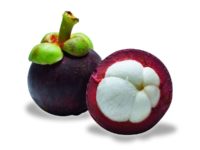
Mangosteen | (มังคุด – Mangkud) | Garcinia mangostana
The mangosteen often called ‘the queen of fruits’, comes from a tropical evergreen tree grows mainly in Southeast Asia, but also in Puerto Rico and Florida. Historically speaking, mangosteens originated in Indonesia, and are mentioned in 15th-century Chinese literature. They were even introduced to English greenhouses in the 19th century, and are said to have been a favorite of Queen Victoria, even though the tree does not flourish outside the tropics.
The tangy, sweet and white juicy flesh of the fruit is an absolute must-try while visiting Phuket. The flesh is protected by a tough and thick reddish-purplish rind (careful as it can stain your clothing), which is relatively simple to discard, while the seeds are sizable and almond-shaped. The taste of the mangosteen was once described as “intoxicatingly luscious”; and indeed, it’s quite an experience to try one if you’re a first-timer here. The mangosteen season extends from the end of May to October.
Nutritional value (concise) per 100 gr – Calories 73:
Carbohydrate 17.91 g / Fat 0.58 g / Protein 0.41 g
Vitamin C 2.9 mg / Vitamin B 0.426 mg
Potassium 48 mg / Phosphorus 8 mg / Magnesium 13 mg / Calcium 12 mg / Sodium 7 mg / Iron 0.3 mg / Manganese 0.102 mg / Zinc 0.21 mg
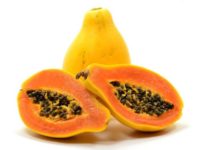
Papaya | (มะละกอ – Malakaw) | Carica papaya
In Thailand, papayas are consumed in two ways: the first way is when the unripe and skinned inner flesh of the fruit is shredded, than added to fish sauce, lemon juice, garlic, chilies, cherry tomatoes and other seasonal vegetables, and becomes part of Thailand’s ubiquitous ‘som tam’ salad (a dish you’ll see Thai people enjoying around the kingdom at all times of day); and the second way is to eat it ripe when its flesh is orange, which of course is a much sweeter way of consuming it, and it’s often served up with a few drops of lime juice, complementing or being complemented by other fruit.
The papaya ‘tree’ grows and can be found everywhere, from the poshest hotel gardens to roadside verges or right outside your kitchen window. The fruit was introduced to Thailand about 200 years ago and originated in South America. Growing year-round, the popularity of this cylindrical fruit is largely due to its availability and high yield.
Nutritional value (concise) per 100 gr – Calories 43:
Carbohydrate 10.82 g / Fat 0.26 g / Protein 0.47 g
Vitamin C 62 mg / Vitamin B 0.698 mg (Folate 38 mcg) / Vitamin E 0.3 mg / Vitamin A 47 mcg / Vitamin K 2.6 mcg
Potassium 182 mg / Phosphorus 10 mg / Magnesium 21 mg / Calcium 20 mg / Sodium 8 mg / Iron 0.25 mg / Manganese 0.04 mg / Zinc 0.08 mg
Water 88 g / Lycopene 1828 mcg

Passion Fruit | (เสาวรส – Saowarod) | Passiflora edulis
Passion fruit in Thailand (‘saowarod’ in Thai) has a brittle yet thick wrinkled yellow rind enclosing flesh-covered seeds, something resembling a pomegranate. Originating in South America, passion fruit is more commonly sieved to get rid of the seeds and its deliciously aromatic lemon-like pulp. Its juice is used as flavoring and enhancements for beverages, sauces, syrups, and jellies. The pulp has a marked yet subtle aromatic flavor, while the texture is jelly-like and watery. The taste is often likened to guava.
Passion fruit grows all year round in the kingdom and is commonly available at fresh markets. You can also notice them growing in the wild if your eyesight is sharp enough to see this vine-like plant. Passion fruit is a rich source of antioxidants, minerals, vitamins, and fiber. 100 g of this fruit contains about 97 calories, and it’s also rich in vitamin C, providing about 30 mg per 100 g.
Nutritional value (concise) per 100 gr – Calories 97:
Carbohydrate 22.4 g / Fat 0.7 g / Protein 2.2 g
Vitamin C 30 mg / Vitamin B 1.73 mg / Vitamin A 64 mcg / Vitamin K 0.7 mcg
Potassium 348 mg / Phosphorus 68 mg / Magnesium 29 mg / Calcium 12 mg / Sodium 28 mg / Iron 1.6 mg / Zinc 0.1 mg
Water 72.9 g
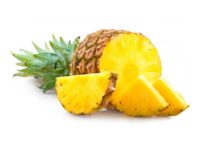
Pineapple | (สัปปะรด – Saparod) | Ananas comosus
It’s a relatively little-known, but fascinating fact, that pineapples are actually made up of many flowers fused together around a central core stem, with each ‘eye’ representing a flower. Another lesser-known detail of this scaly and popular fruit is that the lower part of the pineapple contains significantly more sugar that the rest of its body.
Thailand is the world’s largest producer and exporter of pineapples, accounting for some 50% of the worldwide crop, even though it’s not native to the kingdom. Originating in South America, pineapples were brought to Southeast Asia at the end of the 16th century, and the fruit has since flourished in the tropical humid climate of this region.
Sweet and succulent on the inside, with a rough and inedible exterior, pineapples are rich in vitamin C, B1, antioxidants, digestive-friendly enzymes, and are beneficial for eyesight, yet have a high acidic content unless cooked. There is no particular season for pineapples in Thailand as they flourish all year long.
Nutritional value (concise) per 100 gr – Calories 50:
Carbohydrate 13.12 g / Fat 0.12 g / Protein 0.54 g
Vitamin C 47.8 mg / Vitamin B 0.936 mg
Potassium 109 mg / Phosphorus 8 mg / Magnesium 12 mg / Calcium 13 mg / Sodium 1 mg / Iron 0.29 mg / Manganese 0.927 mg / Zinc 0.12 mg
Water 86 g
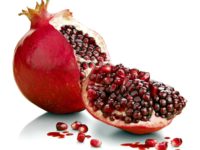
Pomegranate | (ทับทิม – Tubtim) | Punica granatum
The pomegranate originated in the larger area of modern-day Iran and has been cultivated since ancient times throughout the Mediterranean and northern India regions. It thrives in Southeast Asia, but is particularly partial to drier areas, and has been present here for several thousand years. Pomegranates aren’t hard to find in Thailand and, like passion fruit with whom they share many characteristics and its texture, can be used to flavor and enhance dishes and drinks.
Called ‘tub tim’ in Thai, pomegranates are sometimes sold in small plastic bottles in juice form, which in fact is the most preferable way to enjoy the fruit for many people. The many seeds are separated from the rind and internal white pulp membranes by floating a dissected pomegranate in a bowl of water, as the seeds sink and the inedible pulp floats. Another way of separating the rind and seeds is to turn half a pomegranate upside down and gently smack the rind with a spoon to encourage the seeds to fall into a receptacle. Simple and delicious, as well as healthy!
Nutritional value (concise) per 100 gr – Calories 83:
Carbohydrate 18.7 g / Fat 1.17 g / Protein 1.67 g
Vitamin C 10.2 mg / Vitamin B 0.865 mg / Vitamin E 0.6 mg / Vitamin K 16.4 mcg
Potassium 236 mg / Phosphorus 36 mg / Magnesium 12 mg / Calcium 10 mg / Sodium 3 mg / Iron 0.3 mg / Manganese 0.119 mg / Zinc 0.35 mg
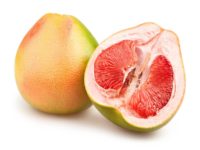
Pomelo | (ส้มโอ – Som-O) | Citrus maxima
With the entirely logical Latin moniker ‘Citrus maxima’, the pomelo is indeed the largest citrus fruit on earth, resembling an oversized grapefruit, and sometimes reaching the size of a football. A native to Southeast Asia, the pomelo is eaten raw with salt, added to salads, and made into beverages. It tastes similar to the grapefruit (although slightly sweeter and milder) and, like the grapefruit, it also has sacs of juice that explode deliciously as you bite into it. Be sure to remove the inner protective membranes as they are inedible. The outer rind is noticeably thicker than its counterpart, and it’s not unusual to see pomelos being handled relatively roughly at local markets without damage.
The pomelo’s many health benefits include its ability to boost the immune system, fight signs of premature aging, improve digestion, lower blood pressure, reduce cramping, fight anemia, strengthen bones, prevent cancer, protect heart health, aid in weight loss, and improve oral and dental health. Ask the fruit vendor to cut your pomelo up for you, and watch closely as it’s quite a fascinating process. Pomelos are generally available year-round, but officially they’re in season from October to February.
Nutritional value (concise) per 100 gr – Calories 38:
Carbohydrate 9.62 g / Fat 0.04 g / Protein 0.76 g
Vitamin C 61 mg / Vitamin B 0.317 mg
Potassium 216 mg / Phosphorus 17 mg / Magnesium 6 mg / Sodium 1 mg / Iron 0.11 mg / Manganese 0.017 mg / Zinc 0.11 mg
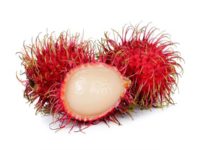
Rambutan | (เงาะ – Ngoh) | Nephelium lappaceum
This decidedly unusual looking fruit is a native to Southeast Asia, and delights visitors who find its messy rock-star hair look highly entertaining (think of the drummer in ‘The Muppet Show’). The rambutan is actually around to oval single-seeded berry with leathery reddish skin, covered with fleshy pliable spines, hence the name which roughly means ‘hairs’.
The fruit flesh is translucent, similar to the lychee or longan, whitish or very pale pink, with a sweet mildly acidic flavor very reminiscent of grapes. Although visually unappealing, the seeds can be cooked and eaten. It’s possible for the rambutan tree to bear fruit twice annually (autumn and spring), and you’ll have no problem finding some to sample in Thailand as the country is the largest producer of rambutan in the world. Health-wise, this fruit is very beneficial, as it contains significant volumes of gallic acid which protects the body from free radicals.
Nutritional value (concise) per 100 gr – Calories 82:
Carbohydrate 20.87 g / Fat 0.21 g / Protein 0.65 g
Vitamin C 4.9 mg / Vitamin B 1.407 mg
Potassium 42 mg / Phosphorus 9 mg / Magnesium 7 mg / Calcium 22 mg / Sodium 11 mg / Iron 0.35 mg / Manganese 0.343 mg / Zinc 0.08 mg
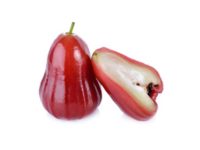
Rose Apple | (ชมพู่ – Chompoo) | Syzygium samarangense
The Thais call the rose apple ‘chompoo’ or ‘champoo’, which simply means pink. Taken on its outward appearance, it resembles a small pear, although the skin appears distinctively waxy compared to the more textured pear outer layer.
When you cut the rose apple open, you won’t find a core filled with seeds, as it’s more or less hollow with a bit of inedible membrane that should be scraped out and discarded. The texture is somewhere between a watermelon and an apple as is the taste, and the fruit should be eaten whole. It has a slightly bitter aftertaste, but this is rarely unpleasant.
There are several varieties of rose apples, with the most common in Thailand having light green skin. This variety is available almost year-round, while seasonal varieties vary in color from apple red to almost black. In Southern Thailand, you’ll also see a small cherry-red strain that looks a bit like a child’s toy top. Rose Apples are a rich source of vitamin C.
Nutritional value (concise) per 100 gr – Calories 25:
Carbohydrate 5.7 g / Fat 0.30 g / Protein 0.60 g
Vitamin C 22.3 mg / Vitamin B 0.850 mg
Potassium 123 mg / Phosphorus 8 mg / Magnesium 5 mg / Calcium 29 mg / Iron 0.07 mg / Zinc 0.06 mg
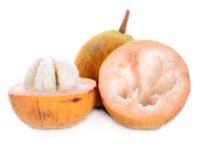
Santol | (กระท้อน – Kratoan) | Sandoricum koetjape
Santols sometimes referred to as the ‘wild mangosteen’, are often the size and shape of a peach and share the same fuzzy skin, along with a reddish tinge. Some strains may contain a milky juice, while the central pulp near the seeds may be sweet or sour, and contains inedible brown seeds, just like mangosteen. In some varieties, the outer rind is thicker and is actually the main edible portion with a mild peachy taste. combined with the pulpy texture of apples. In others, the outer rind is thinner and harder, and the inner whitish pulp around the seeds is edible.
In Thai cuisine, when it is unripe, the santol is used to make a delicious ‘som tam’. It’s also one of the complementary ingredients of Thai pork and prawn curries. It is extremely important to avoid eating the santol seeds, as they can prove to be fatal and require surgery to remove from the intestine. The season to find Santol in the markets in Thailand is from July to October.
Nutritional value (concise) per serving – Calories 40:
Carbohydrate 10 g / Fat 0.10 g / Protein 0.118 g
Vitamin C 86 mg / Vitamin B 0.786 mg / Vitamin A 3 mcg
Phosphorus 17.4 mg / Magnesium 5 mg / Calcium 4.3 mg / Iron 0.2 mg
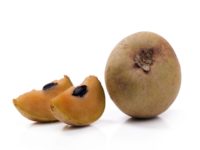
Sapodilla | (ละมุด – Lamud) | Manilkara zapota
Sapodilla is one of the more common fruits in Phuket, and a favorite of farmers here because of its strong resistance to molds and pests, so much so that farmers often don’t have to bother with chemical pesticides and fungicides. The fruit looks like a small potato and, when unripe, is hard and highly astringent and sappy with latex which lessens as it ripens, but you’ll probably still notice the rubbery texture.
You’ll know when sapodilla is ready to eat as it becomes as soft as a ripe kiwi fruit, and you just have to peel it as you would a pear. The ripe flavor is intense, similar to a pear dipped in butter and sugar, and the brown flesh has a constituency of its own, with four bean-shaped inedible black seeds embedded in it. Health-wise, the sapodilla has a full range of benefits, but it can be relatively heavy in calories. Sapodilla is in season between July and December in Thailand.
Nutritional value (concise) per 100 gr – Calories 83:
Carbohydrate 19.96 g / Fat 1.1 g / Protein 0.44 g
Vitamin C 14.7 mg / Vitamin B 0.519 mg
Potassium 193 mg / Phosphorus 12 mg / Magnesium 12 mg / Calcium 21 mg / Sodium 12 mg / Iron 0.8 mg / Zinc 0.1 mg
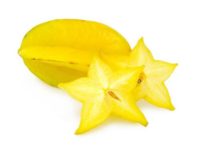
Star Fruit | (มะเฟือง – Mafaeng) | Averrhoa carambola
The star fruit (also named carambola), popular throughout Asia, has distinctive ridges running down its body, and when looked at in cross-section looks like a five-pointed star, hence its name. Unusually, the entire fresh fruit is edible and may also be used in cooking as well as made into preserves, relishes, and juices.
It’s best consumed when ripe when it’s yellow with a delicate shade of green. It will also have brown ridges at the five edges and feels firm to the touch. An overripe fruit will be yellow with brown spots. When fully ripe, it’s sweet with a hint of sour and is extremely juicy. The taste is difficult to describe, but it’s been likened to a combination of orange, papaya, and grapefruit at the same time.
Like many fruits in Phuket, star fruit is eaten by the locals with a dash of sugar and chili. With very low sugar content and rich in antioxidants, the fruit is definitely a healthy snack. In season towards the end of the year.
Nutritional value (concise) per 100 gr – Calories 31:
Carbohydrate 6.73 g / Fat 0.33 g / Protein 1.04 g
Vitamin C 34.4 mg / Vitamin B 0.519 mg / Vitamin E 0.5 mg / Vitamin A 66 mcg
Potassium 133 mg / Phosphorus 12 mg / Magnesium 10 mg / Calcium 3 mg / Sodium 2 mg / Iron 0.8 mg / Manganese 0.037 mg / Zinc 0.12 mg
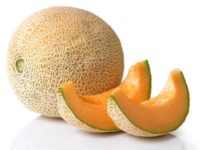
Sugar Melon | (แคนตาลูป – Cantalope) | Cucumis melo cantalupensis
The sugar melon is another name for the Thai cantaloupe which is a luscious, delicious and versatile fruit that is at home as an out-and-out dessert as well as complementing meats. Cantaloupes can be traced back 4,000 years in Africa and India.
There are two types of cantaloupe in Thailand: the green cantaloupe and the orange strain. The orange is the sweeter and is softer in flesh, emitting a highly seductive and alluring scent. The green cantaloupe is firmer and can be used in smoothies and curries. Both are healthy, as they contain high amounts of vitamins good for bones and teeth, and both are a diuretic, meaning that they’ll clean you out in no time!
The cantaloupe is unique in its genre in both fragrance and its flesh’s feel. Most melons are crisp, and simply do not have the same dense and sticky feel that a cantaloupe enjoys. Largely grown in Kanchanaburi, Aranyaprathet and Sa Kaeo provinces, the Thai cantaloupe is available year-round.
Nutritional value (concise) per 100 gr – Calories 34:
Carbohydrate 8.16 g / Fat 0.19 g / Protein 0.84 g
Vitamin C 36.7 mg / Vitamin B 0.971 mg / Vitamin A 169 mcg / Vitamin K 2.5 mcg
Potassium 267 mg / Phosphorus 15 mg / Magnesium 12 mg / Calcium 9 mg / Sodium 16 mg / Iron 0.21 mg / Manganese 0.041 mg / Zinc 0.18 mg
Water 90.2 g

Tamarind | (มะขาม – Makahm) | Tamarindus indica
Known as ‘makham’ in Thai, Thailand has the largest plantations of the ASEAN nations, producing this pod-like bitter-sweet fruit that is so popular throughout Asian and world cuisine. The fruit of the tamarind tree has a fleshy, juicy and acidic pulp. It is mature when the flesh is colored brown or reddish-brown, and Asian tamarinds have long pods containing 6 to 12 seeds.
The tamarind taste is best described as sweet and sour and, health-wise is high in B vitamins, tartaric acid, sugar and, strangely enough for a fruit, calcium. The ripened fruit is considered more palatable than the out-and-out bitter unripe tamarind (although unripened tamarind has its uses as additives to curries). As it becomes sweeter, it grows less acidic and is often used in desserts, jams, blended into sweetened drinks, juices, sorbets, ice creams and more. Even though it’s widely considered a sweetener, believe it or not, that Worcestershire sauce you add to your soups to spice them up is largely made up of tamarind, and many barbecue sauces contain significant amounts of the fruit juice.
Nutritional value (concise) per 100 gr – Calories 239:
Carbohydrate 62.5 g / Fat 0.6 g / Protein 2.8 g
Vitamin C 3.5 mg / Vitamin B 2.727 mg / Vitamin E 0.1 mg / Vitamin K 2.8 mcg
Potassium 628 mg / Phosphorus 113 mg / Magnesium 92 mg / Calcium 74 mg / Sodium 28 mg / Iron 2.8 mg / Manganese 0.041 mg / Zinc 0.1 mg
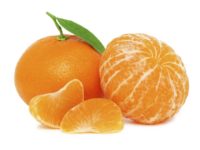
Tangerine | (ส้มเขียวหวาน – Som Kiewwaan) | Citrus reticulata
The Thai name for oranges in the kingdom is ‘som kiew waan’, which literally translates as ‘sweet green orange’. This says it all, really! Small and with a leathery almost puffy skin, Thai oranges are sweet and low in acidic content and are ideally suited for that morning juice packed with vitamins that your body needs and appreciates after a good night’s sleep.
In truth, Thai oranges can easily be mistaken for what we take as tangerines, and it’s a fact that they do share many of the same properties. In more temperate climes, oranges grow with a greener hue, so you’ll get both types in Thailand, depending on where you are. Either type has vitamin C-packed orange flesh though. If you order a fresh orange juice here, it often will be served with a dash of salt, so make sure you specify if you don’t want this addition. Thai oranges are in season from September to February.
Nutritional value (concise) per 100 gr – Calories 53:
Carbohydrate 13.34 g / Fat 0.31 g / Protein 0.81 g
Vitamin C 26.7 mg / Vitamin B 0.764 mg / Vitamin E 0.2 mg / Vitamin A 34 mcg
Potassium 166 mg / Phosphorus 20 mg / Magnesium 12 mg / Calcium 37 mg / Sodium 2 mg / Iron 0.5 mg / Manganese 0.039 mg / Zinc 0.07 mg
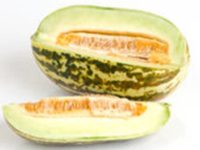
Thai Melon | (แตงไทย – Tangtai) | Cucumis melo
Cylindrical in shape and seemingly packed with rows of seeds, the Thai melon is a lesser-known (and some would say unique) strain of an old favorite. With a light green and very sweet flesh, this is a tasty item that can weigh up to three kilos. Thai melons also come on cylindrical yellow strains and oval yellow, but all have the same delicate summery flavor.
You’d be forgiven for mistaking the average Thai melon for a huge cucumber at first sight, as both have distinctive white lines on a green skin or rind, but there the resemblance abruptly stops. Health-wise, the Thai melon is high in vitamins and is a diuretic as well as a supreme refresher on a hot afternoon. Perfect for smoothies and juices, it is sometimes served up with coconut milk and sugar palm.
Nutritional value (concise) per 100 gr – Calories 34:
Carbohydrate 8.16 g / Fat 0.19 g / Protein 0.84 g
Vitamin C 36.7 mg / Vitamin B 0.971 mg / Vitamin A 169 mcg / Vitamin K 2.5 mcg
Potassium 267 mg / Phosphorus 15 mg / Magnesium 12 mg / Calcium 9 mg / Sodium 16 mg / Iron 0.21 mg / Manganese 0.041 mg / Zinc 0.18 mg
Water 90.2 g
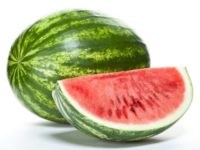
Watermelon | (แตงโม – Tangmo) | Citrullus lanatus
Ubiquitous in Thailand, as it grows all year round, watermelons (‘tangmo’ in Thai) are a staple part of Thai mixed fruit platters, and are excellent at complementing spicy food. Thai watermelon is much the same strain as the European and North American types. It’s a very nutritious fruit, rich in most of the important antioxidants in nature. Besides vitamins A and C, watermelon contains lycopene, an efficient free radical scavenger that helps protect against chronic diseases.
Thai people commonly use watermelon peel as a vegetable ingredient in their curry dishes (watermelon rind sour curry). Watermelon is even a mild libido-enhancer! Watermelon smoothies are wonderful pick-me-ups on a hot day. Be aware that Thais add syrup to their drinks, so, if you want to stay away from too much sweetening when ordering ‘nam tang-mo’ (watermelon juice), you should ask the service staff to keep yours ‘tamachat’ or ‘natural’ with no additives.. it’s sweet enough as it is!
Nutritional value (concise) per 100 gr – Calories 30:
Carbohydrate 7.55 g / Fat 0.15 g / Protein 0.61 g
Vitamin C 8.1 mg / Vitamin B 0.498 mg / Vitamin A 28 mcg
Potassium 166 mg / Phosphorus 11 mg / Magnesium 10 mg / Calcium 7 mg / Sodium 1 mg / Iron 0.24 mg / Manganese 0.038 mg / Zinc 0.1 mg
Water 91.45 g / Lycopene 4532 mcg
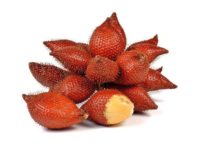
Zalacca | (สลัก – Salak) | Salacca zalacca
Looking for the entire world like elongated mutant lychee, the zalacca (aka salacca and ‘salak’ in Thai) grows in clusters at the base of the plant and, again like lychee, the zalacca has scaly reddish skin with white pulpish flesh and inedible seeds. In broader terms, the zalacca is sometimes called the snake fruit because of its scaly rind.
The fruit has high levels of potassium and pectin and contains many nutrients such as thiamine, iron, and calcium, as well as vitamin C. It also possesses anti-diarrhea properties, which can indeed result in constipation if you eat too many.
Indigenous to Indonesia, where it’s as common as apples in Europe, the zalacca also grows well in Thailand. Taste-wise, the inside is sweet and sour like a pineapple, and very juicy when ripe. Locals enjoy this fruit dipped in sugar or salt. The zalacca fruit is not widespread when in season in Thailand… you’re more likely to see them for sale at farmers’ markets or at roadside stands. So keep an eye out!
Nutritional value (concise) per 100 gr – Calories 368:
Carbohydrate 12.1 g / Fat 0.4 g / Protein 0.8 g
Vitamin C 8.4 mg / Vitamin B-2(riboflavin) 0.2 mg
Phosphorus 18 mg / Calcium 38 mg / Iron 3.9 mg
Water 86.4 g
Here we complete our journey into this quite interesting and fascinating visit to our ‘Thai fruit mini orchard’, where we found some of the most popular and easily available fruits in Phuket. By no means do we have the pretension to say that we have covered all the Thai fruits available in the markets around the kingdom, but we do hope that this little introduction to the world of fruits in Phuket, with its different (some might say: ‘unusual’) ways local people enjoy those fruits, will provide you with the incentive to try and discover how some of these ‘unheard-of’ or ‘ever-seen-before’ fruits taste like.
Remember, as mentioned in the introduction, that Thai people have long ago realized how to balance sweet, salty, sour and bitter in a manner that brings out the best in each one of these fruits. So, on your next visit to this luxurious fruit garden of Thailand, make it your ‘mission’ to try it the ‘local way’, even if it’s only out of curiosity.
Go for it, you’ll enjoy the journey!





